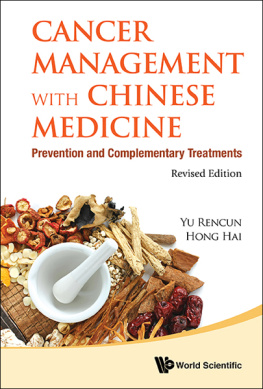Hochhauser Daniel - Cancer and its Management
Here you can read online Hochhauser Daniel - Cancer and its Management full text of the book (entire story) in english for free. Download pdf and epub, get meaning, cover and reviews about this ebook. City: Chichester;West Sussex;Hoboken;New Jersey, year: 2015;2014, publisher: Wiley Blackwell, genre: Home and family. Description of the work, (preface) as well as reviews are available. Best literature library LitArk.com created for fans of good reading and offers a wide selection of genres:
Romance novel
Science fiction
Adventure
Detective
Science
History
Home and family
Prose
Art
Politics
Computer
Non-fiction
Religion
Business
Children
Humor
Choose a favorite category and find really read worthwhile books. Enjoy immersion in the world of imagination, feel the emotions of the characters or learn something new for yourself, make an fascinating discovery.
- Book:Cancer and its Management
- Author:
- Publisher:Wiley Blackwell
- Genre:
- Year:2015;2014
- City:Chichester;West Sussex;Hoboken;New Jersey
- Rating:4 / 5
- Favourites:Add to favourites
- Your mark:
- 80
- 1
- 2
- 3
- 4
- 5
Cancer and its Management: summary, description and annotation
We offer to read an annotation, description, summary or preface (depends on what the author of the book "Cancer and its Management" wrote himself). If you haven't found the necessary information about the book — write in the comments, we will try to find it.
Cancer and its Management — read online for free the complete book (whole text) full work
Below is the text of the book, divided by pages. System saving the place of the last page read, allows you to conveniently read the book "Cancer and its Management" online for free, without having to search again every time where you left off. Put a bookmark, and you can go to the page where you finished reading at any time.
Font size:
Interval:
Bookmark:

This edition first published 2015 2015 by John Wiley & Sons, Ltd.
2005, 2003, 1998, 1995, 1987, 1986 by R. Souhami and J. Tobias,
2010 J. Tobias and D. Hochhauser
Blackwell Publishing was acquired by John Wiley
Registered office: John Wiley & Sons, Ltd, The Atrium, Southern Gate, Chichester, West Sussex, PO19 8SQ, UK
Editorial offices: 9600 Garsington Road, Oxford, OX4 2DQ, UK
The Atrium, Southern Gate, Chichester, West Sussex, PO19 8SQ, UK
111 River Street, Hoboken, NJ 07030-5774, USA
For details of our global editorial offices, for customer services and for information about how to apply for permission to reuse the copyright material in this book please see our website at www.wiley.com/wiley-blackwell
The right of the author to be identified as the author of this work has been asserted in accordance with the UK Copyright, Designs and Patents Act 1988.
All rights reserved. No part of this publication may be reproduced, stored in a retrieval system, or transmitted, in any form or by any means, electronic, mechanical, photocopying, recording or otherwise, except as permitted by the UK Copyright, Designs and Patents Act 1988, without the prior permission of the publisher.
Designations used by companies to distinguish their products are often claimed as trademarks. All brand names and product names used in this book are trade names, service marks, trademarks or registered trademarks of their respective owners. The publisher is not associated with any product or vendor mentioned in this book. It is sold on the understanding that the publisher is not engaged in rendering professional services. If professional advice or other expert assistance is required, the services of a competent professional should be sought.
The contents of this work are intended to further general scientific research, understanding, and discussion only and are not intended and should not be relied upon as recommending or promoting a specific method, diagnosis, or treatment by health science practitioners for any particular patient. The publisher and the author make no representations or warranties with respect to the accuracy or completeness of the contents of this work and specifically disclaim all warranties, including without limitation any implied warranties of fitness for a particular purpose. In view of ongoing research, equipment modifications, changes in governmental regulations, and the constant flow of information relating to the use of medicines, equipment, and devices, the reader is urged to review and evaluate the information provided in the package insert or instructions for each medicine, equipment, or device for, among other things, any changes in the instructions or indication of usage and for added warnings and precautions. Readers should consult with a specialist where appropriate. The fact that an organization or Website is referred to in this work as a citation and/or a potential source of further information does not mean that the author or the publisher endorses the information the organization or Website may provide or recommendations it may make. Further, readers should be aware that Internet Websites listed in this work may have changed or disappeared between when this work was written and when it is read. No warranty may be created or extended by any promotional statements for this work. Neither the publisher nor the author shall be liable for any damages arising herefrom.
Library of Congress Cataloging-in-Publication Data has been applied for.
ISBN 978-1-118-46873-9
A catalogue record for this book is available from the British Library.
Wiley also publishes its books in a variety of electronic formats. Some content that appears in print may not be available in electronic books.
Fluorescence microscopy of human endothelium highlighting cadherin (green) between cells. Image courtesy of Wikimedia Commons under the GNU Free Documentation License.
To Susan and Jo, with love and thanks
In the 4 years that have elapsed since the previous edition of this book was published, we have been astonished by the number of changes made necessary by the introduction of newer treatments for cancer. Once again we can say without fear of contradiction that both our understanding of the biology, causation and natural history of many malignant tumours has continued to move forward. Equally and perhaps even more important, the outlook at least for some types of cancer has improved, in a number of cases, quite dramatically. Patients now have access to a far more integrated and seamless service, with multidisciplinary teams meeting regularly to discuss all aspects of patient management, resulting in a more balanced and expert approach to decision-making. They are increasingly managed by well-informed specialists with particular experience and expertise in their field of practice, and communication between general practitioners, hospital specialist and community services have continued to improve. Palliative care teams, which only 10 years ago were unevenly distributed even in economically developed parts of the world, have now become more fully accepted and much more widely available.
New chemotherapeutic agents and targeted therapies have appeared at a remarkably rapid rate, and in many cases have become fully established as part of standard treatment regimens breast, lymphoma, colorectal cancer and melanoma are good examples. We noted this development in the Preface to this book when it last appeared in 2010, and these innovations have progressed still further since then. It seems hard to believe that targeted therapies, so widely used today, have been available for less than 20 years, the first of these, the monoclonal antibody rituximab, appearing and achieving licence for use as recently as 1997. As we have previously remarked, it remains an exciting time to be in cancer medicine, though it is profoundly important to remember that the human, pastoral and technical lessons of the past do not change. We have tried to stress this in the specific site-related chapters, particularly since increasing levels of specialization carry the real danger that tomorrow's specialists will so to speak know more and more about less and less. Broadly speaking, we accept as so many others do that the benefits of site specialization clearly outweigh the disadvantages, but nonetheless it is as well to remember that most patients look to their specialist oncologist for far more than simply his or her technical expertise.
As we pointed out in the Preface to previous editions, a textbook limited to this size and designed to be widely comprehensible demands that only essential information can be presented. We have had to synthesize and abbreviate a variety of expert opinions and summarize interesting or unresolved controversies, which, in a larger text, would have been the subject of more detailed discussion. Nonetheless, we hope the result is an accessible text that avoids being too didactic in tone or synoptic in style. The aim of the book has not altered: it is to provide an introductory text for medical staff, nurses and other allied professionals, students and scientists interested in and challenged by the problems of cancer care.
Initially, we wrote this book because we were aware that many busy physicians, surgeons and gynaecologists, who are not themselves cancer specialists, may find it difficult to keep abreast in areas that are nonetheless of crucial importance in their professional lives. General surgeons, for example, spend a substantial portion of their time dealing with gastrointestinal and abdominal tumours, yet have little working knowledge of the non-surgical treatment of these conditions. Similarly, gynaecological surgeons need to know in a fair degree of detail about what the radiotherapist and medical oncologist can offer.
Next pageFont size:
Interval:
Bookmark:
Similar books «Cancer and its Management»
Look at similar books to Cancer and its Management. We have selected literature similar in name and meaning in the hope of providing readers with more options to find new, interesting, not yet read works.
Discussion, reviews of the book Cancer and its Management and just readers' own opinions. Leave your comments, write what you think about the work, its meaning or the main characters. Specify what exactly you liked and what you didn't like, and why you think so.













